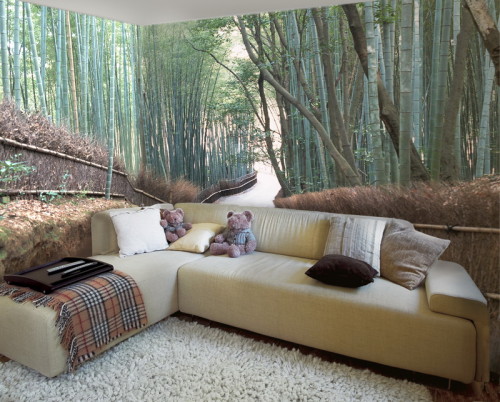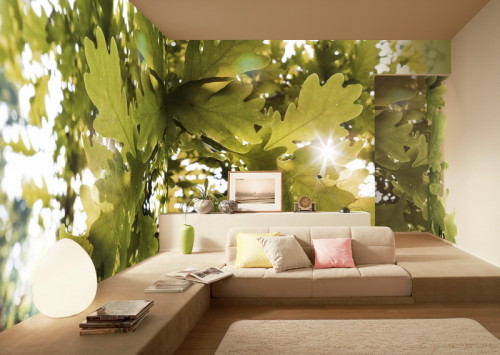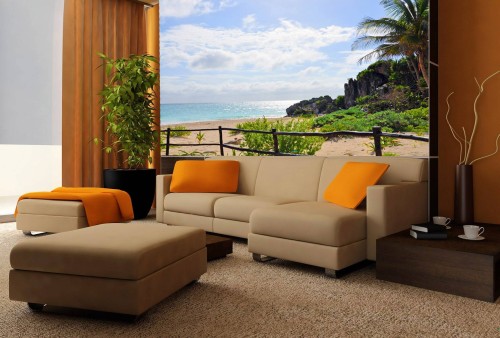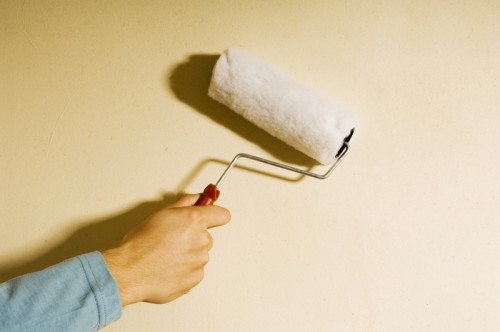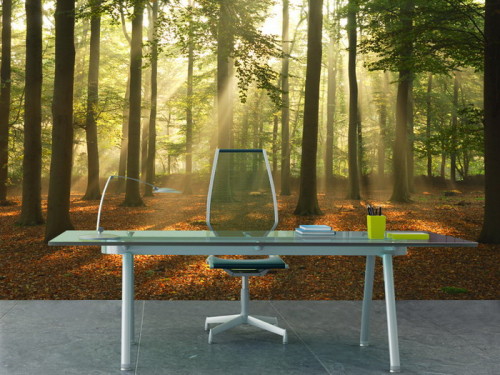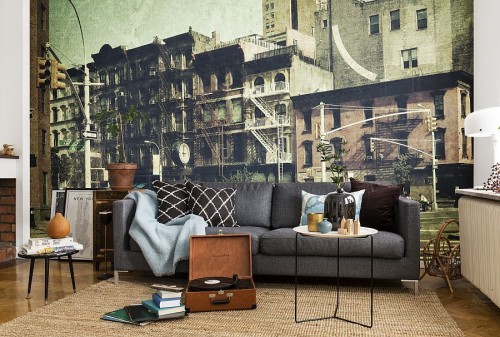
How to glue photo wallpapers on the wall Wallpaper,Walls
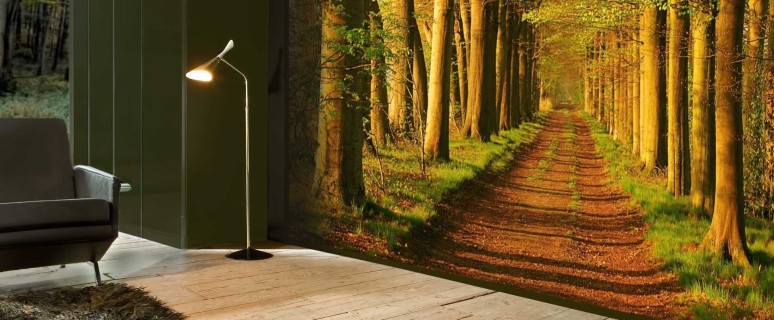
Wall mural makes it possible to noticeably transform the interior, give him uniqueness. Modern material for sticking is a high-quality decorative lining with a drawdrid or photo. Wall mural is divided into several species depending on the material used for their base.
Content
Varieties of materials
- For paper photographs on the wall as a basis, a special photo paper is used. In some cases, sheets are covered with matte or glossy protective film. They have a small density and are not resistant to mechanical damage. And also from such photographic, it is impossible to eliminate pollution with water, since the impact of moisture has a devastating effect on this material. At the same time, their positive qualities are high ecological indicators.
- Vinyl wallpapers of high resolution on the wall. The PVC film is used as the basis for their manufacture. The material has a protective coating in the form of a glossy or matte film. Such wallpapers have an adhesive basis, thanks to which they got the name "self-adhesive". They can only be applied to absolutely even smooth bases. For example, for mirrors, glass, wooden surfaces, laminated MDF. Before sticking, vinyl photographes are abundantly wetted with soapy solution, therefore the surface to which they are pasted should be resistant to moisture. These wallpapers have water resistance, and also retain their color under the influence of sun rays.
- Wall murals on a fliesline basis possess the property to skip air, steam and moisture. Different with sufficient strength, superior in this regarding photo wallpapers on a paper basis. In the process of sticking, the adhesive composition is applied only on the wall, which facilitates and speeds up the work. Also, this technological feature allows you to avoid deformations and bubbles. As a rule, children's photo wallpapers on the wall are made from such a material due to their hypoality and accessibility.
- Textile photographes have a big density relatively to other varieties. In addition, they are resistant to the influence of various destructive factors and have sufficient flexibility.
Mural on the wall. Photo:
Paper photo packing technology
One of the conditions for high-quality shocking of photo wallpaper is a properly prepared surface:
- It must be treated with primer. It should be borne in mind that it is necessary to use only good quality primer. High-quality primer contains special components that penetrate the surface structure, strengthen it without creating films. Due to this, the foundation acquires vapor-permeable qualities, and this in turn ensures the penetration of the glue part into the base structure and after drying it firmly fixes the wallpaper on the wall.
- It should be noted that the poor-quality primer does not have the ability to penetrate into the base, and can penetrate into a layer of putty only by 1 mm, resulting in a steamproof film. This may cause the wallpaper detachable. You can distinguish a quality product in price.
- In the premises of the work it is necessary to provide a certain temperature mode, which must be below 12 ° C. Under low temperature conditions for absorbing and drying, the adhesive will require much more time.
- The level of humidity should not exceed 50%.
- The working surface must have a homogeneous light color.
The tool that is necessary for sticking:
- building level;
- pencil, ruler and roulette;
- scissors;
- wallpaper knife;
- plastic spatula with rounded edge;
- plastic roller roller;
- brush;
- small pile roller;
- sponge and towel.
At the next step, it is necessary to prepare wallpaper. To do this, unpack the roll and cut the cloth to 2-3 parts. At the same time, for each band, 10 cm should be left as a stock for accurate adjustment adjustment. An important point is the matching pattern. The image on the subsequent canvase should match the image on the previous one. To make sure the cloths must be pasted 2 or 3 fragments and suspend work before they dry. The color of the wallpaper will become uniform and it will be possible to visually determine the correctness of the image.
There are 3 methods of sticking paper photo wallpapers on the wall:
- In accordance with the first strip, you need to put down the image and apply the glue through a thin layer by the roller. Next, the canvas folds inside the treated side approximately 3 minutes. During this time, the glue swelling occurs. It is important to apply the desired amount of adhesive composition. Wallpapers should not be very wetted, since in this case they lose strength. In the process of gluing the excess glue should not be out of the joints. Special attention should be paid to the edges, you can not allow them to dry.
- According to the second method, the cut fragment of wallpaper should be placed down, the opposite side with the help of a wind moistened with warm water. In order to apply need the amount of water to correctly determine the thickness and density of the material. The glue is applied at the moment of absorption by wallpaper of moisture, after which you can begin to stick.
- The third method applies to a specific category of wallpaper. The presence on the label of the designation "Prepaasted" suggests that wallpaper is already treated with adhesive composition. Such material you just need to moisten. To do this, the cut fragment of wallpaper must be twisted into the roll and loaded into the water with warm temperature. Then the wallpaper should be removed, shake the excess water, deploy and fold inside the side treated by glue for 2 minutes. After that, decompose and glue to the surface. Finally, you must fix the seam. To do this, it needs to be swallowed by the tip of the spatula or roll through the rubber roller.
Punching of self-adhesive photo wallpaper
This type of wallpaper in terms of adhesive technology has a significant advantage over traditional materials. These sheets have an adhesive basis, so when working with them does not require the use of wallpaper glue and water. This significantly speeds up and facilitates work. Also, it is not necessary to provide a certain temperature in the room and the level of humidity. Features of the technological process are reduced to the following:
- The basis for which it is supposed to secure self-adhesive wallpapers on the wall should be even. Vinyl wallpaper is quite thin, so all deformation changes will be visible through them.
- In the presence of irregularities, the base should be plastered and polished, after which they apply a soil composition on an acrylic basis.
- In addition to eliminating irregularities, the surface also needs to be deguted. This can be done using conventional detergents or alkaline solutions.
The process of how to glue photo wallpapers on the wall is as follows:
- From the reverse side of the material, a paper coating is removed approximately by 5 cm. The web is fixed to the surface first by this fragment.
- Then you need to remove the remaining paper and continue sticking.
- The glued strip should be smoothed with a towel to eliminate possible folds and bubbles.
- If bubbles stayed, these places need to pierce with a needle. After the air will be released material must be placed.
- To cover the corners of the material, the wallpaper should first be heated using a conventional hair dryer, after which the edges bent. In order for the edges to be smooth, the wallpaper must be cut at an angle of 45 °.
- After sticking the first fragment, it is important to correctly dock the second strip.
- With a canvase, the coating is removed in the same way along the entire length, the material is applied to the base and the band is rolled.
Features of sticking in a children's, living room and kitchen
The main criteria to be navigated when choosing photo wallpaper for children is environmental safety and water resistance. For this room, the best choice will be washable wallpaper, since the children love to engage in creativity - sculpt and draw as a result of which the walls are rapidly polluted. Do not stop your choice on paper wallpaper. In this case, a more appropriate option will be wallpaper on phliselin, vinyl or textile base. An important point is also a color scheme. For the nursery, you should choose the wallpaper of calm tones: pink, peach, yellow, light blue.
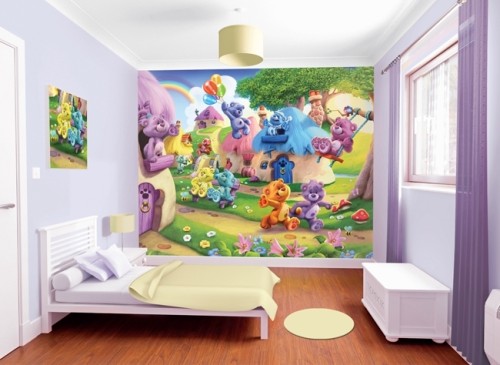
In the living room, the best option for wallpaper accommodation will be a seating area, near the sofa or chairs. So wallpapers will be in the almelings of visibility and, sitting on the sofa, it will be possible to contemplate the landscape, a sea or a waterfall, which will contribute to relaxation. The interior of the living room is recommended to issue in the style of minimalism, placing a small number of furniture and decor in it. The most appropriate background for color photo wallpapers on the wall in the living room will be monophonic walls, and for black and white - walls of bright shades. Thus, the photo wallpaper will create a certain focus indoor. Wallpapers of cold tones are suitable for a light living room. If there is a lack of light in the room, you should give preference to warm tones.
With this facing material, you can transform the kitchen room. In this case, in addition to the aesthetic purposes of the photo wallpaper on the wall of the kitchen, the practical problem is performed, because This room is usually multifunctional. The use of photo wallpapers will allow to divide the space on the zone. And also to adjust the imperfect layout and visually expand the room.
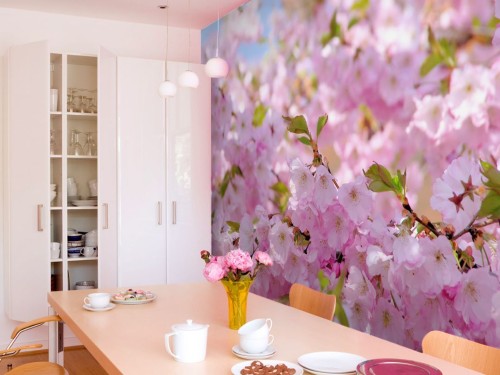
Conclusion
Wallpaper with applied image can be applied in any interior and allow you to embody any designer solutions. Wall murals are divided into several types that differ from each other used. Each species has certain features that need to be considered in the process of sticking.




